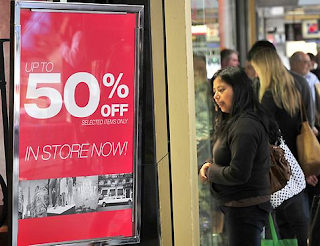Consumer Spending Juiced by Inflation
 The Personal Income and Outlays Report was published Friday for the month of February, and was received welcomingly by the market. It offered news of a jump in consumer spending, and any sign of such a gain for our consumer driven economy is sure to spur enthusiastic response. Still, I warn investors and economy watchers to temper their enthusiasm, as the day’s pill contains poison.
The Personal Income and Outlays Report was published Friday for the month of February, and was received welcomingly by the market. It offered news of a jump in consumer spending, and any sign of such a gain for our consumer driven economy is sure to spur enthusiastic response. Still, I warn investors and economy watchers to temper their enthusiasm, as the day’s pill contains poison.  Our founder earned clients a 23% average annual return over five years as a stock analyst on Wall Street. "The Greek" has written for institutional newsletters, Businessweek, Real Money, Seeking Alpha and others, while also appearing across TV and radio. While writing for Wall Street Greek, Mr. Kaminis presciently warned of the financial crisis.
Our founder earned clients a 23% average annual return over five years as a stock analyst on Wall Street. "The Greek" has written for institutional newsletters, Businessweek, Real Money, Seeking Alpha and others, while also appearing across TV and radio. While writing for Wall Street Greek, Mr. Kaminis presciently warned of the financial crisis.Consumer Spending Juiced
The monthly Personal Income & Outlays Report for February highlighted a 0.8% jump in personal outlays, or Personal Consumption Expenditures (PCE). The spending increase surpassed the prior month’s revised gain of 0.4% (hiked from the +0.2% initially reported). Indeed, it was welcomed good news, exceeding the economists’ consensus forecast for a 0.6% rise. The strong tally was at the very top of the economists’ range in fact, which spanned from 0.2% to 0.8%, according to Bloomberg. However, there is a fly in the ointment.
The gain in consumer spending was juiced, you see, by an unsavory ingredient. The unnatural driver was found in prices, as the PCE Price Index reflected in its 0.3% creep higher. Therefore, Real PCE, adjusted for price changes, rose at a lesser 0.5%. Obviously, the key driver of price rise today is found in petroleum and distillates, due to Iranian related concerns. NYMEX Crude Oil Futures for the nearest term contract now sit steadily above $100, specifically at $103.57 at the hour of scribbling here on March 30, 2012. A look at the iPath S&P GSCI Crude Oil TR Index ETN (NYSE: OIL) chart for February tells the story. The petroleum price driven security traded 8.9% higher through the month. A similar gain is seen in the Teucrium WTI Crude Oil ETF (NYSE: CRUD).
The Core PCE Price Index, which weeds out food and energy prices, rose just 0.1%, so true inflation concerns were tempered Friday. However, you’ll want to read an article we have planned to follow this report, addressing what we expect will be a rise in real inflation.
February’s data showed consumer spending increased 4.1% on a year-over-year basis, which matched the January’s gain. The yearly data should be smoothed and not vary between months, except for when special factors come to play (like 9/11). The PCE Price Index was up 2.3% on a yearly comparison, which is not very concerning. The Fed will likewise find little to worry about in the Core PCE yearly change, which measured at +1.9% in February. The Federal Reserve is said to favor PCE Price Index as a measure of inflation, and so the data point is worthy of your regular inspection.
February’s report showed Personal Income rose 0.2% month-to-month, and was up 3.2% on a yearly comparison. The yearly change was down sharply from January’s 3.5% change, though I suspect bonus payments add some noise to the data, though remain worth inspection. Unfortunately, Real Disposable Income, adjusted for price changes, fell by 0.1% in February. The Personal Savings Rate also declined in the month, to 3.7% of disposable income, versus 4.3% in January.
In conclusion, I’m not as enthused by the report as the market seemed to be Friday. A couple hours ahead of the close of trading, the SPDR S&P 500 (NYSE: SPY) was up about a half point, making up ground for what had been a poor week. The Consumer Discretionary Select Sector SPDR (NYSE: XLY) was up a bit more, as should be expected. However, the SPDR S&P Retail (NYSE: XRT) was down fractionally.
You may also like: March Madness for Consumers
Article interests investors in: S&P Retail ETF (NYSE: XRT), Wal-Mart (NYSE: WMT), Pier 1 Imports (NYSE: PIR), Ethan Allen (NYSE: ETH), Hooker Furniture (Nasdaq: HOFT), Home Depot (NYSE: HD), Lowes (NYSE: LOW), Apple (Nasdaq: AAPL), Best Buy (NYSE: BBY), The Limited (NYSE: LTD), Chicos (NYSE: CHS), Ann Taylor (NYSE: ANN), The Gap (NYSE: GPS), Macy’s (NYSE: M), JC Penney (NYSE: JCP), Nordstrom (NYSE: JWN), TJX Company (NYSE: TJX), Kohls (NYSE: KSS), Costco (Nasdaq: COST), Target (NYSE: TGT), Wet Seal (Nasdaq: WTSLA), Hot Topic (Nasdaq: HOTT), American Eagle Outfitters (NYSE: AEO), Aeropostale (NYSE: ARO), Abercrombie & Fitch (NYSE: ANF), Saks (NYSE: SAK), Tiffany (NYSE: TIF), Talbots (NYSE: TLB), Lumber Liquidators (NYSE: LL), Builders Firstsource (Nasdaq: BLDR), Fortune Brands (NYSE: FO), Leggett & Platt (NYSE: LEG), Tempur-Pedic International (NYSE: TPX), Acuity Brands (NYSE: AYI), La-Z-Boy (NYSE: LZB), Select Comfort (Nasdaq: SCSS), Sleepy’s (NYSE: ZZ), Furniture Brands (NYSE: FBN), Natuzzi (NYSE: NTZ), Sears (Nasdaq: SHLD), Dillard’s (NYSE: DDS), Bon-Ton (Nasdaq: BONT), Cost Plus (Nasdaq: CPWM), Baker’s Footwear (Nasdaq: BKRS.OB), Bebe Stores (Nasdaq: BEBE), The Buckle (NYSE: BKE), Cache (Nasdaq: CACH), Casual Male (Nasdaq: CMRG), Cato (Nasdaq: CATO), Christopher & Banks (NYSE: CBK), Citi Trends (Nasdaq: CTRN), Collective Brands (NYSE: PSS), Destination Maternity (Nasdaq: DEST), Dress Barn (Nasdaq: DBRN), DSW (NYSE: DSW), Finish Line (Nasdaq: FINL), Footlocker (NYSE: FL), Gymboree (Nasdaq: GYMB), Guess (NYSE: GES), J. Crew (NYSE: JCG), Jones New York (NYSE: JNY), Jos. A Banks (Nasdaq: JOSB), New York & Co. (NYSE: NWY), Men’s Wearhouse (NYSE: MW), Syms (Nasdaq: SYMS), The Children’s Place (Nasdaq: PLCE).
Please see our disclosures at the Wall Street Greek website and author bio pages found there. This article and website in no way offers or represents financial or investment advice. Information is provided for entertainment purposes only.

Labels: consumers, Consumers-2012-Q1, Economic-Reports, Economic-Reports-2012-03, Inflation

















